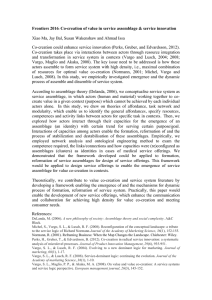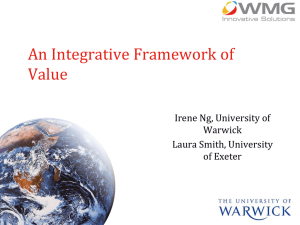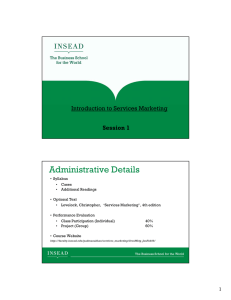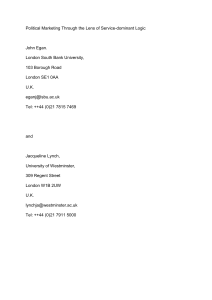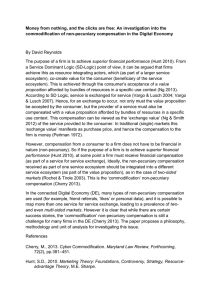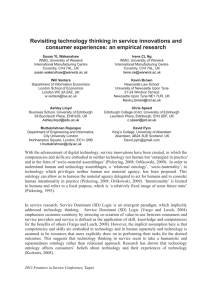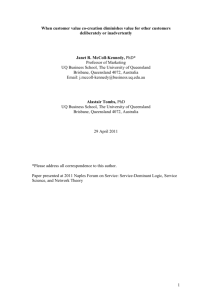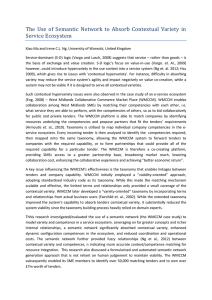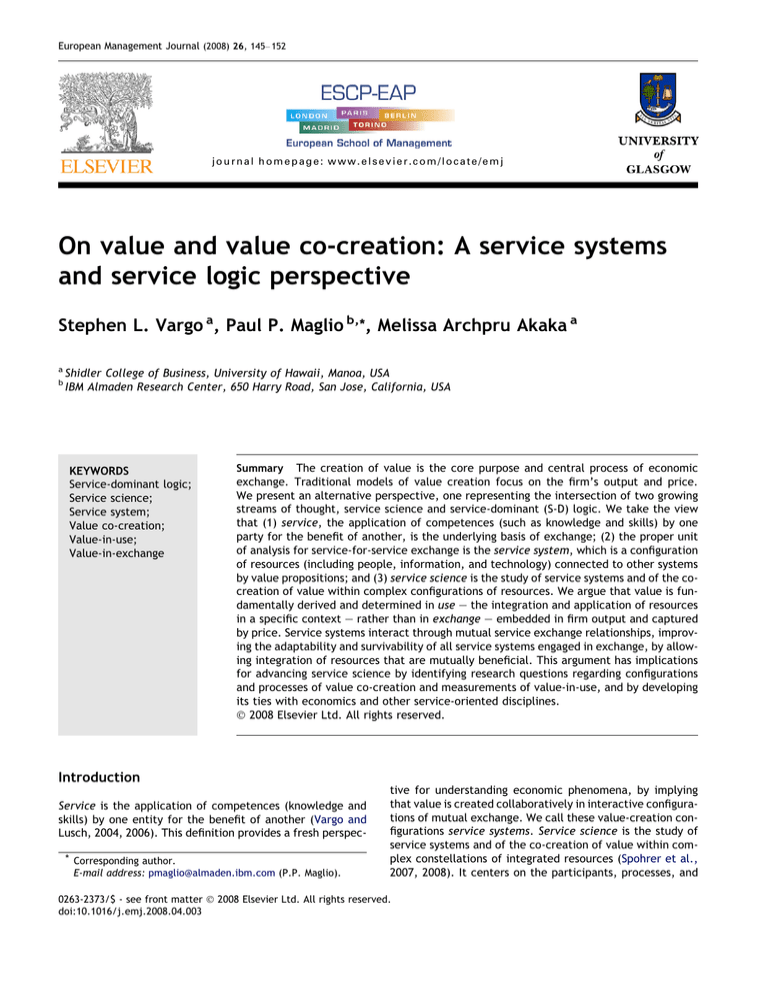
European Management Journal (2008) 26, 145– 152
journal homepage: www.elsevier.com/locate/emj
On value and value co-creation: A service systems
and service logic perspective
Stephen L. Vargo a, Paul P. Maglio b,*, Melissa Archpru Akaka a
a
b
Shidler College of Business, University of Hawaii, Manoa, USA
IBM Almaden Research Center, 650 Harry Road, San Jose, California, USA
Available online
KEYWORDS
Service-dominant logic;
Service science;
Service system;
Value co-creation;
Value-in-use;
Value-in-exchange
Summary The creation of value is the core purpose and central process of economic
exchange. Traditional models of value creation focus on the firm’s output and price.
We present an alternative perspective, one representing the intersection of two growing
streams of thought, service science and service-dominant (S-D) logic. We take the view
that (1) service, the application of competences (such as knowledge and skills) by one
party for the benefit of another, is the underlying basis of exchange; (2) the proper unit
of analysis for service-for-service exchange is the service system, which is a configuration
of resources (including people, information, and technology) connected to other systems
by value propositions; and (3) service science is the study of service systems and of the cocreation of value within complex configurations of resources. We argue that value is fundamentally derived and determined in use – the integration and application of resources
in a specific context – rather than in exchange – embedded in firm output and captured
by price. Service systems interact through mutual service exchange relationships, improving the adaptability and survivability of all service systems engaged in exchange, by allowing integration of resources that are mutually beneficial. This argument has implications
for advancing service science by identifying research questions regarding configurations
and processes of value co-creation and measurements of value-in-use, and by developing
its ties with economics and other service-oriented disciplines.
Ó 2008 Elsevier Ltd. All rights reserved.
Introduction
Service is the application of competences (knowledge and
skills) by one entity for the benefit of another (Vargo and
Lusch, 2004, 2006). This definition provides a fresh perspec* Corresponding author.
E-mail address: pmaglio@almaden.ibm.com (P.P. Maglio).
tive for understanding economic phenomena, by implying
that value is created collaboratively in interactive configurations of mutual exchange. We call these value-creation configurations service systems. Service science is the study of
service systems and of the co-creation of value within complex constellations of integrated resources (Spohrer et al.,
2007, 2008). It centers on the participants, processes, and
0263-2373/$ - see front matter Ó 2008 Elsevier Ltd. All rights reserved.
doi:10.1016/j.emj.2008.04.003
146
resources that interact to create value in service systems. So
value and value creation are at the heart of service and are
critical to understanding the dynamics of service systems
and to furthering service science. But value is an elusive
term.
The nature of value has been discussed and debated
since Aristotle. Part of its elusiveness stems from the oblique – if not orthogonal – meanings of value that have been
embedded in the foundations of economics and the study of
market exchange. Specifically, two general meanings of
value, ‘‘value-in-exchange’’ and ‘‘value-in-use’’, reflect
different ways of thinking about value and value creation.
The traditional view is referred to as goods-dominant
(G-D) logic and is based on the value-in-exchange meaning
of value (see Vargo and Lusch, 2004; Vargo and Morgan,
2005). In G-D logic, value is created (manufactured) by
the firm and distributed in the market, usually through exchange of goods and money. From this perspective the roles
of ‘‘producers’’ and ‘‘consumers’’ are distinct, and value
creation is often thought of as a series of activities performed by the firm.
Consider an automobile. A manufacturing firm constructs
an automobile out of metal, plastic, rubber, and other
parts, arranges them precisely, and packages them together. In their raw form, the metal and other components
cannot be used as transportation. According to G-D logic,
the firm’s production process creates value for customers
through the manufacturing and delivery of an automobile.
That is, the automobile manufacturing firm embeds value
in the automobile by transforming raw materials into something that customers want. In this sense, value is created by
the firm in the form of a good, and this valuable good is exchanged in the marketplace for money (or possibly other
goods). Value is measured by this exchange transaction.
The alternative view, service-dominant (S-D) logic, is
tied to the value-in-use meaning of value (Vargo and Lusch,
2008a). In S-D logic, the roles of producers and consumers
are not distinct, meaning that value is always co-created,
jointly and reciprocally, in interactions among providers
and beneficiaries through the integration of resources and
application of competences.
Consider the automobile again. As before, a manufacturing firm applies its knowledge, skills, and capabilities to
transform raw materials into an automobile. But according
to S-D logic, the automobile is only an input into the value
creation that occurs as a customer uses it (in transportation,
self-identity, etc.) and integrates it with other resources. If
no one knew how to drive, had access to fuel and maintenance, and functioned in social networks for which particular automobiles had particular meanings, etc., the car
would have no value. It is only when the customer makes
use of the automobile – in the context of his or her own
life – that it has value. In this case, customers and manufacturers co-create value: manufacturers applying their
knowledge and skills in the production and branding of the
good, and customers applying their knowledge and skills in
the use of it in the context of their own lives. At the same
time, customers integrate and apply their own resources
to provide service (often exchanged in the form of service
rights – money – that the firm can use for its own valuecreating activities). Value is co-created by this reciprocal
and mutually beneficial relationship.
S.L. Vargo et al.
S-D logic is foundational to service science and to the
study of value-creation in service systems (Maglio and Spohrer, 2008; Spohrer et al., 2008). The study of service systems emphasizes collaboration and adaptation in value cocreation, and establishes a balanced and interdependent
framework for systems of reciprocal service provision.
These systems can be individuals or groups of individuals
(e.g., families, firms, nations, etc.) that survive, adapt,
and evolve through exchange and application of resources
– particularly knowledge and skills – with other systems.
Simply put, service systems engage in exchange with other
service systems to enhance adaptability and survivability
– thus, co-creating value – for themselves and others.
In this paper, we explore alternative views of value in
economic exchange and establish a service science conceptualization of value co-creation, providing a framework for
rethinking value and how it is created in service systems.
First, we review alternative logics of economic exchange
and their associated meanings of value in some detail. Second, we discuss the meaning of value and how it is derived
and determined in service systems. Third, we describe the
process of value co-creation through interaction and integration of resources within and among service systems. Finally, we connect our exploration and elaboration of value
and value co-creation in service systems to the development
of service science and more broadly, to research opportunities in understanding the process and assessment of value
creation in service systems.
Alternative views on value
Contention over the definition of value is ancient, dating
back at least to Aristotle, who first distinguished between
two meanings: ‘‘use-value’’ and ‘‘exchange value’’ (Aristotle 4th century B.C.). This division came about through
Aristotle’s efforts to address the differences between things
(e.g., automobile) and their attributes, which included the
qualities (e.g., red, fast, sporty), quantities (e.g., one
car), and relations (e.g., lease, ownership) of such things
(Fleetwood, 1997). Use-value was recognized as a collection
of substances or things and the qualities associated with
these collections. For example, an automobile is a collection of qualities, both specific (e.g., red and fast) and overarching (e.g., transportation and status).
The qualities related to use-value mean different things
to different people and thus, are inherently differentiated
and heterogeneous. Alternatively, exchange-value was considered as the quantity of a substance that could be commensurable value of all things. Whereas Aristotle was able
to explain use-value, he had difficulty specifically identifying exchange-value.
Exchange-values are more complex. When one writes 1
hamster = 20 pencils it is not obvious what the commensurable dimension is. Such an equation is meaningless
until one knows by which property they can be rendered
Commensurable. . . There is only one common substance
that renders incommensurable commodities commensurable – although Aristotle does not know what it is.
Whatever it turns out to be, one refers to this substance
as value. The measure of this substance is exchange
value (Fleetwood, 1997, pp. 732–733).
On value and value co-creation: A service systems and service logic perspective
In his attempt to understand exchange value, Aristotle
deliberated over two things he believed could be considered
commensurable in exchange, money and need, and eventually rejected both. He decided that money could not be a
measure of value because for money to measure a substance, the substance itself must already be commensurable. In addition, Aristotle believed that ‘‘need’’ was what
held the process of exchange together, but a person’s need
lacked a unit of measurement. When he attempted to reconcile the two, using money as the measurement of need,
Aristotle deduced that although something holds parties of
exchange together, it does not hold the same value as the
substance exchanged. In the end, Aristotle was never able
to clearly identify a commensurable measure for exchange-value (Fleetwood, 1997).
Although Aristotle was first to distinguish between usevalue and exchange-value (Fleetwood, 1997), the Medieval
Schoolmen are recognized for emphasizing use-value in economic exchange and arguing that the basis of exchange was
found in the needs of consumers (Dixon, 1990). Prior to the
formal development of economics, use-value was regularly
acknowledged by those who recognized the role of satisfaction and fulfillment in value. Galiani (1751, p. 304) noted,
‘‘it is certain that nothing has a price among men except
pleasure, and that only satisfactions are purchased’’ (see
Dixon, 1990, for history of use-value). The definition of
use-value was widely accepted among early schoolmen
and philosophers, and there was little debate about it at
the time. However, the controversy over a commensurable
metric of exchange value remained it was embedded in the
development of economic thought, largely by Smith’s (1776)
early distinction of real value, labor, and nominal value,
money.
Foundations of goods-dominant logic
Adam Smith (1776) brought the discussion of value and value
creation into the development of economics and the study
of market exchange. According to Smith (1776/2000,
p. 31, emphasis in original), ‘‘the word VALUE, it is to be
observed has two different meanings, and sometimes
expresses the utility of some particular object, and sometimes the power of purchasing other goods which the possession of that object conveys.’’ Smith called them
‘‘value-in-use’’ and ‘‘value-in-exchange’’ respectively,
and explained that ‘‘the things which have the greatest
value in use have frequently little or no value in exchange;
and on the contrary, those which have the greatest value in
exchange have frequently little or no value in use’’ (Smith,
1776/2000, p. 31).
Smith (1776) based his views on the efficiency of the division of labor – actually, the application of specialized skills
and knowledge – and exchange. He explained that ‘‘real value’’ was found in the effort or labor required to afford the
necessities and pleasures of life, thus tying it to value-in-use
like the earlier schoolmen, and that ‘‘nominal value’’ was
the price paid in market exchange. But after recognizing labor as the real basis for value, Smith noted the challenges
with measuring labor and, for reasons discussed below, directed his work toward value embedded in commodities
(tangible exchange) and their monetary or nominal value.
147
Smith’s focus on nominal value and tangible exchange represented a departure from the previously accepted focus
on use-value and has had critical implications for the development of economics and understanding of market exchange (Vargo and Lusch, 2004).
Although Smith is often recognized as the father of economics, it was not his intention to develop a science of economics. In fact, Smith was not really concerned with all
processes or purposes of exchange, only those that contributed to the wealth of England at the time (Vargo and Morgan, 2005). Because of limitations on international travel
and lack of communication technologies, the primary source
of national wealth was through production and exportation
of surplus tangible goods. Smith also felt that exchange
value, value-in-exchange, was easier to understand.
Given these perspectives, Smith’s shifted his emphasis to
value-in-exchange and focused on what he deemed ‘‘productive’’ activities, those that contributed to exchange
value through the manufacturing and distribution of tangible goods. Although he recognized the essential nature of
some labor not connected with the production of surplus
goods (e.g., doctors and lawyers), he called this labor
‘‘unproductive’’ because it did not result in units of output
that were tangible and exportable.
The economic scholars (e.g., Say, 1821; Mill, 1929) who
followed Smith (1776) generally disagreed with his classifications of productive and unproductive labor, and recognized that all activities that contributed to well-being
were productive (had value-in-use). But Smith’s model of
value embedded and distributed in tangible goods fit well
with the increasing desire to turn economic philosophy into
an economic science. At that time, the model of ‘‘science’’
was Newtonian Mechanics, the study of matter embedded
with properties, and so most scholars ultimately accepted
Smith’s view of productive activities, which was focused
on the output of tangible resources. The ‘‘product’’ (good)
embedded with ‘‘utilities’’ (exchange-value) became the
focus of neoclassical economics grounded in marginal utility
theory (Marshal, 1927; Walras, 1954). And so, economic science became grounded on a foundation of goods-dominant
logic and nominal exchange value.
Rethinking value and value creation:
service-dominant logic
The S-D logic view of exchange fundamentally challenges
the foundation of economics (see Vargo and Lusch, 2004),
though in a real sense, it recaptures Smith’s (1776) original
notions of applied, specialized knowledge and skills (service) and value-in-use (real value) as primary. As noted, in
the G-D logic view, the purpose of economic exchange is
to make and distribute things to be sold. A firm’s production
process, which may include resources from other firms, embeds value or utility into a good, and the value of the good is
represented by the market price or what the consumer is
willing to pay. From this perspective, maximum efficiency –
and maximum profit – is achieved by standardization and
economies of scale.
The S-D logic view is that all exchange is based on service, and that ‘‘when goods are involved, they are tools
for the delivery and application of resources’’ (Vargo
148
S.L. Vargo et al.
et al., 2006, p. 40). That is, goods are service-delivery vehicles. In S-D logic, knowledge and skills are key resources for
competitive advantage (see also Johnson et al., 2005). The
crux of the contrast between service-dominant and goodsdominant logic lies in the basis of exchange. S-D logic
focuses on the action of operant resources (those that act
upon other resources), such as knowledge and skills,
whereas G-D logic focuses on the exchange of operand
resources (those that an act or operation is performed on,
such as goods) (Constantin and Lusch, 1994; Vargo and
Lusch, 2004).
For S-D logic, value results from the beneficial application of operant resources, which are sometimes transmitted
through operand resources or goods (Vargo and Lusch,
2004). Thus, from this view, value is co-created through
the combined efforts of firms, employees, customers,
stockholders, government agencies, and other entities related to any given exchange, but is always determined by
the beneficiary (e.g., customer). Table 1 provides an overview of the major differences between G-D logic and S-D logic related to value and value creation. Table 2 provides the
ten foundational premises of S-D logic (as revised in Vargo
and Lusch, 2008a).
The S-D logic notion of value co-creation suggests that
‘‘there is no value until an offering is used – experience
and perception are essential to value determination’’ (Vargo and Lusch, 2006, p. 44). That is, offerings must be integrated with other market-facing (i.e., from other firms) and
non-market-facing (e.g., personal/private and public) resources for value to be created – as in the example of a
car gaining its value only through the combination of the
manufacturer’s production processes (including its supply
chain and other market-facing elements) and the customer’s private (e.g., driving skills) and public (e.g., roadways) resources.
The firm’s roles in value creation, the proposition of value and provision of service, are intermediary to the value
Table 1
Table 2
Foundational premises of S-D logic
Premise
number
Foundational premise
FP1
FP2
Service is the fundamental basis of exchange.
Indirect exchange masks the fundamental basis
of exchange.
Goods are a distribution mechanism for service
provision.
Operant resources are the fundamental source of
competitive advantage.
All economies are service economies.
The customer is always a co-creator of value.
The enterprise can not deliver value, but only
offer value propositions.
A service-centered view is inherently customer
oriented and relational.
All social and economic actors are resource
integrators.
Value is always uniquely and phenomenologically
determined by the beneficiary.
FP3
FP4
FP5
FP6
FP7
FP8
FP9
FP10
co-creation process. Value propositions establish connections and relationships among service systems. In value
co-creation, value is ultimately derived with the participation of, and determined by, the beneficiary (often, the customer) through use (often called ‘‘consumption’’) in the
process of acquisition, usage, and disposal (Holbrook,
1987).
Normann (2001) provides additional insight on the conceptualization and process of consumption with two contrasting dictionary definitions: ‘‘consume’’ means
‘‘destroy’’ or ‘‘use up’’ or ‘‘waste’’, and ‘‘consummate’’
means ‘‘complete’’ or ‘‘perfect’’. Though G-D logic seems
to rely on the first definition of consume, S-D logic relies
G-D logic vs. S-D logic on value creation
Value driver
Creator of value
Process of value creation
Purpose of value
Measurement of value
Resources used
Role of firm
Role of goods
Role of customers
G-D logic
S-D logic
Value-in-exchange
Firm, often with input from firms in a
supply chain
Firms embed value in ‘‘goods’’ or
‘‘services’’, value is ‘added’ by
enhancing or increasing attributes
Increase wealth for the firm
Value-in-use or value-in-context
Firm, network partners, and customers
The amount of nominal value, price
received in exchange
Primarily operand resources
Produce and distribute value
Units of output, operand resources that
are embedded with value
To ‘use up’ or ‘destroy’ value created by
the firm
Firms propose value through market offerings,
customers continue value-creation process
through use
Increase adaptability, survivability, and system
wellbeing through service (applied knowledge
and skills) of others
The adaptability and survivability of the
beneficiary system
Primarily operant resources, sometimes
transferred by embedding them in operand
resources-goods
Propose and co-create value, provide service
Vehicle for operant resources, enables access to
benefits of firm competences
Co-create value through the integration of firmprovided resources with other private and public
resources
On value and value co-creation: A service systems and service logic perspective
on the second conceptualization (though generally avoids
using the term). Like S-D logic, the latter definition considers the role of the service beneficiary as a value creator
rather than as a value destroyer. Of course, value creation
usually requires resources beyond a two-party system, often
involving a firm, its customers, suppliers, employees, stockholders, and other network partners (Lusch and Vargo,
2006; Normann and Ramirez, 1993).
With value-in-use at center stage of a complex valuecreation process, the service-centered view of exchange
suggests that knowledge (and skills) is ubiquitous in the
market and is generated by all participants. When value creation is seen from a service systems perspective, the producer–consumer distinction disappears and all participants
contribute to the creation of value for themselves and for
others. S-D logic captures this equivalence of participants
and their roles in FP9: all economic and social actors are resource integrators (Vargo and Lusch, 2008a). Likewise, the
concept of value-in-use is potentially extended to a more
descriptive ‘‘value-in-context’’ (Vargo et al., in press) by
the combination of FP9 and FP10: value is uniquely and phenomenolgically determined by the beneficiary.
Value and value creation in service systems
Moving the locus of value creation from exchange to use, or
context, means transforming our understanding of value
from one based on units of firm output to one based on processes that integrate resources. We think this move is fundamental for the development of service science, which
aims to focus scientific attention on problems associated
with innovating service and enhancing service provision
(Chesbrough and Spohrer, 2006; Spohrer et al., 2006). And
we think the service system is a useful abstraction for
understanding value and value co-creation in this way (see
also Maglio and Spohrer, 2008 and Spohrer et al., 2008).
Specifically, for service systems, we define value simply in
terms of an improvement in system well-being and we can
measure value in terms of a system’s adaptiveness or ability
to fit in its environment.
In the following section, we consider how these notions
of improvement and environmental fit can help us understand and measure value-in-use, and what this means for
service science.
149
Deriving and determining value
A service system is an arrangement of resources (including
people, technology, information, etc.) connected to other
systems by value propositions (Spohrer et al., 2007; Spohrer
et al., 2008). A service system’s function is to make use of
its own resources and the resources of others to improve its
circumstance and that of others. One way to acquire resources is through the exchange of a system’s applied operant resources (service) with those of other service systems.
We can consider individuals, groups, organizations, firms,
and governments to be service systems if they can take action, apply resources, and work with others in mutually beneficial ways.
A barber is an individual who applies skill and experience
using scissors, shampoo, and other resources to style a customer’s hair. A firm may provide IT outsourcing service(s) by
applying knowledge and skills of its employees along with
processes and technologies it has in-house to set up and
run the IT of another firm. In both cases, systems (the barber and tools, or the outsourcing firm and technologies) deploy their capabilities in conjunction with other systems (an
individual with hair and preferences, or client firm with
existing IT systems and applications to be supported). And
in both cases, systems work together in mutually beneficial
ways.
Service systems co-create value, effectively depending
on the resources of others to survive. This interdependence
drives service-for-service exchange and resource integration. We see service-for-service as the basis of economic exchange, and we think this view can reframe the relationship
among value-in-exchange, value-in-use and value co-creation (see Figure 1).
Service systems are connected through the proposition,
acceptance, and evaluation of value (Spohrer et al.,
2008). Service providers propose value in the market based
on their competences and capabilities (skills and knowledge). The value proposition is accepted, rejected, or unnoticed by other service systems in need of resources. The
service proposed can be provided directly (e.g., tax preparation service) or indirectly through a good (e.g., tax software). Once the value is proposed and the service made
available in the market, it is up to other service systems –
potential customers – in need of such resources to decide
Value-in-Context for Service System 1
Value-in-Context for Service System 2
Access, Adapt and Integrate Resources
Access, Adapt and Integrate Resources
Service System
(Public)
Service System
(Private)
Service System
(Public)
Service System 1
(Firm)
Service System 2
(Customer)
Value-in-Use
Derived Value
Value-in-Use
Derived Value
Service System
(Market-facing)
Value-in-Exchange
Value Proposition/
Money
Figure 1
Value co-creation among service systems.
Service System
(Private)
Service System
(Market-facing)
150
whether to accept the value proposition. For example, if tax
preparation services are being offered, some service systems (e.g., customers) will accept the proposition of value
and make a decision to exchange money for the knowledge,
skills, and time of a person specialized in tax preparation. In
other cases, customers may reject the direct service and
opt for a more indirect service – using tax software. In
either case, the applied resources (service) of the provider
must be integrated with the competences and resources of
the beneficiary before value is realized.
In the direct case, the tax preparation documents must
be signed, submitted, and held for statutory periods and
used as input to future tax filings. They also serve as input
into future tax-related decisions and other activities, such
as mortgage application processes. In the indirect case,
the customer must still integrate the embedded knowledge
and skills of the service provider (i.e., firm) – the competence and capabilities built into the software – with his or
her own related skills, time and other resources (such as a
computer), as well as the resources used in the case of direct service provision. In each case, the resource- and
use-contexts result in uniquely determined value – valuein-use or value-in-context (see Vargo and Lusch, 2008a).
So the goal of exchange is to use the applied knowledge
of others (service) as resources to better one’s circumstances. In exchange among service systems, value is determined through use or integration and application of operant
(and sometimes operand) resources (Lusch and Vargo,
2006). As with the tax preparation example, value is not
created until the beneficiary of the value proposition (in this
case, the person who needs his or her taxes prepared) has
actually had his or her taxes prepared and has somehow
integrated this new resource into his or her life (e.g., felt
relieved because of effort saved, mailed the return, received a refund, etc.). That is, the customer’s (service
system’s) well-being has somehow been improved.
As mentioned, value co-creation is not limited to the
activities of any one exchange or a dyad of service systems.
It occurs through the integration of existing resources with
those available from a variety of service systems that can
contribute to system well-being as determined by the system’s environmental context. Each service system accesses
resources from other service systems through exchange.
These systems include internal (e.g., own, employees), private (e.g., friends, stockholders), and market-facing (suppliers, other economic exchanges) systems and resources.
Value-in-exchange is the negotiated measurement offered
and received (e.g., money and value proposition) among exchange partners. The resources of the service provider are
adapted and integrated with a service system’s existing resources, and value is derived and determined in context –
as with the tax and automobile examples above. The process continues as new knowledge is generated and exchange
occurs within and among surrounding systems.
S.L. Vargo et al.
enous to the process of value creation, the contextual nature of co-created value suggests otherwise. It is not
possible to control all aspects of the environment, but this
does not mean that environmental resources are not integrated to create value (Lusch and Vargo, 2006). Resources
such as time, weather, and laws, which are often considered
uncontrollable by the individuals and organizations, are integrated – if not relied on – in the value creation process by all
service systems (e.g., customers, firms, families, countries).
Although S-D logic and service systems focus on value derived and determined through use or context, value determined by exchange remains an important component in
the co-creation of value. It is possible for value-in-use to exist without value-in-exchange (Vargo and Lusch, 2006), but
when the need to access resources from others arises, so
does the need for value-in-exchange. In other words, value-in-exchange is required for value creation once the resources needed cannot be attained naturally, such as
breathing fresh air versus needing an oxygen tank. Co-creation of value inherently requires participation of more than
one service system, and it is through integration and application of resources made available through exchange that
value is created. The process of co-creating value is driven
by value-in-use, but mediated and monitored by value-inexchange.
Value-in-exchange, therefore, provides a way of measuring relative value within a context of surrounding systems.
But at its core, value depends on the capabilities a system
has to survive and accomplish other goals in its environment.
Taking advantage of the service another system offers means
incorporating improved capabilities. That is, value-in-use
can be defined as system improvement within a particular
environment (cf. Beinhocker, 2006). If one has no income
or lives in a place with no income taxes, there is no need
to enhance one’s capabilities with tax services or tax software. But if one lives in place with income taxes, having
tax preparation capabilities are important to survival (so as
not to go to court, not to go to jail, and so on). Conventionally, we judge the value of things, such as tax preparation
capabilities, by exchanging money for actions or goods.
Our experience and knowledge, and the experience and
knowledge of others in the marketplace, provide hints as
to what is reasonable to exchange for some new capability.
But measuring exchange value in this way – through human
judgment and operationalized in the market – is not necessary for a service system to provide value to another system.
All ways that systems work together to improve or enhance one another’s capabilities – whether measured or
judged or not – can be seen as being value creating. Some
organisms may have symbiotic relationships with others,
completely dependent on one another for food, each dependent on capabilities the other provides. Neither may be
measuring or judging explicitly what is exchanged, but each
provides service for, and creates value with, the other
nonetheless.
Systems of value co-creation
As suggested, the context of value creation is as important to
the creation of value as the competences of the participating parties. Although social, ecological, and governmental
surroundings are often considered uncontrollable and exog-
Implications for service science and service
research
Service science is the interdisciplinary study of service systems, particularly the study of how complex configurations
On value and value co-creation: A service systems and service logic perspective
of resources create value within firms and across firms
(Spohrer et al., 2008). The idea of creating a science of
service arose several years ago, as business and academia
began to discover that most economic activity was driven
by what is conventionally known as ‘‘services’’ (i.e., intangible, heterogeneous, inseparable, and perishable offerings;
Zeithaml et al., 1985) – both within individual firms and
across economies – but that service innovation did not have
the same scientific and engineering bases as manufacturing
or goods innovation (Chesbrough, 2005; IBM Research, 2004;
Horn, 2005; Spohrer et al., 2006).
Now, there is tremendous need for service innovations or
new ways of creating value with intangible and dynamic
resources, to fuel economic growth and to raise the quality
and effectiveness of service(s), especially for knowledgeintensive industries (Spohrer and Maglio, 2008). But it seems
creating systematic service innovation depends on interdisciplinary knowledge and skills, integrating across technology, business, social, and demand innovations (Maglio
et al., 2006). Some have already begun to create interdisciplinary service science education aimed at improving
service innovation (see for instance, Davis and Berdrow,
2008; Glushko, 2008; Larson, 2008). And others have
focused on deep research problems in service by combining
theories and methods from several fields (see for instance,
Oliva and Sterman, 2001; Clarke and Nilsson, 2008; Pitkänen
et al., 2008).
Many service science and service research problems
remain, particularly in the context of value co-creation
through resource integration across service systems. The
service-science, S-D logic framework for value co-creation
presented here fundamentally shifts the underlying focus
of value creation away from the firm’s output and valuein-exchange. It focuses on value-in-use and in-context and
suggests that service systems simultaneously access, adapt
and integrate resources to create value for themselves
and others, and that knowledge is the core source of all
exchange.
This exploration of value co-creation raises as many
questions as it answers. For example: What exactly are
the processes involved in value co-creation? How can we
measure co-created value and value-in-use? How does information technology influence the ways in which value can be
created effectively? What approaches do we need to understand the sociotechnical context of value creation? What
are the research methods appropriate for understanding
value as an emergent quality? Answering questions such as
these will help establish better bases on which to build managerial decision rules. That is, we need to establish the fundamentals of service science and a framework for
understanding how service systems operate and interact
before we can develop a normative service science for what
decision makers of service systems should do (see also Vargo
and Lusch, 2008b).
Previously, we argued that service science depends on SD logic and the abstraction of the service system (Spohrer
and Maglio, 2008; Spohrer et al., 2008). Here, we have
argued that development of service science means reconceptualizing value and value creation. Though this service
science approach to value and value creation does not
ignore traditional understandings and measurements of
value and value creation, it ‘‘forces us to shift our attention
151
from production to utilization, from product to process,
from transaction to relationship. It enhances our sensitivity
to the complexity of roles and actor systems. In this sense
service logic clearly frames a manufacturing logic rather
than replaces it’’ (Normann, 2001, p. 87, emphasis in
original).
There is much to discover about value co-creation and
the potentially endless process of resource integration and
service-for-service exchange. With the advancement of service science, it is increasingly evident that the producer–
consumer distinction is inappropriate and that value is created through the active participation of all service systems
engaged in exchange (see Vargo and Lusch, 2008b). It is
likely that the collaboration and integration of both similar
and competing ideas, from various social and economic
disciplines, will be required to advance the understanding
of value and value creation.
In much the same way that the process of value co-creation drives innovation and evolution within the market, it
also propels the generation of new knowledge in business,
academia, and practice. Thus, the interdisciplinary
exchange of ideas and effort to increase understanding of
value co-creation will not only benefit the development of
service science, but will potentially aid the advancement
of all other social and economic disciplines involved.
References
Aristotle (1959) Politics (4th century B.C.). H. Rackham, trans.
London: Wm. Heinemann.
Beinhocker, E. (2006) The Origin of Wealth: Evolution, Complexity
and the Radical Remaking of Economics. Harvard Business School
Press.
Chesbrough, H. (2005) Toward a science of services. Harvard
Business Review 83, 16–17.
Chesbrough, H. and Spohrer, J. (2006) A research manifesto for
services science. Communications of the ACM 49, 35–40.
Clarke, R. J. and Nilsson, A. G. (2008) Business services as
communication patterns: A work practice approach for analyzing
service encounters. IBM Systems Journal 47(1), 129–142.
Constantin, J. A. and Lusch, R. F. (1994) Understanding Resource
Management. The Planning Forum, Oxford, OH.
Davis, M. M. and Berdrow, I. (2008) Service science: Catalyst for
change in business school curricula. IBM Systems Journal 47(1),
29–40.
Dixon, D. F. (1990) Marketing as production: The development of a
concept. Journal of the Academy of Marketing Science 18(Fall),
337–343.
Fleetwood, S. (1997) Aristotle in the 21st century. Cambridge
Journal of Economics 21, 729–744.
Galiani, F. (1751) Della Moneta. In Early Economic Thought ed.
Arthur E. Monroe. Harvard University Press, Cambridge.
Glushko, R. J. (2008) Designing a service science discipline with
discipline. IBM Systems Journal 47(1), 15–28.
Holbrook, M. B. (1987) What is consumer research? The Journal of
Consumer Research 14(1), 128–132.
Horn, P. (2005) The new discipline of services science: It’s a
melding of technology with an understanding of business
processes and organization – and it’s crucial to the economy’s
next wave. Business Week, January 21.
IBM Research (2004) Services science: A new academic discipline?
Available
at:
<http://www.almaden.ibm.com/asr/SSME/
facsummit.pdf>.
Johnson, B. C., Manyika, J. M. and Yee, L. A. (2005) The next
revolution in interactions. The McKinsey Quarterly 4, 20–33.
152
Larson, R. C. (2008) Service science: At the intersection of
management, social, and engineering sciences. IBM Systems
Journal 47(1), 41–52.
Lusch, R. F. and Vargo, S. L. (2006) Service-dominant logic as a
foundation for a general theory. In The Service-Dominant Logic
of Marketing: Dialog, Debate and Directions, (eds) R. F. Lusch
and S. L. Vargo, pp. 406–420. Sharpe Inc., Armonk.
Maglio, P. P. and Spohrer, J. (2008) Fundamentals of service
science. Journal of the Academy of Marketing Science 36(1),
18–20.
Maglio, P. P., Srinivasan, S., Kreulen, J. T. and Spohrer, J. (2006)
Service systems, service scientists, SSME, and innovation.
Communications of the ACM 49(7), 81–85.
Marshal, A. (1927) Principles of Economics (1890). Reprint, London:
Macmillan.
Mill, J. S. (1929) Principles of the Political Economy (1885).
Reprint, London: Longmans, Green.
Normann, R. (2001) Reframing Business: When the Map Changes the
Landscape. John Wiley and Sons, Chichester.
Normann, R. and Ramirez, R. (1993) From value chain to value
constellation: Designing interactive strategy. Harvard Business
Review(July/August), 65–77.
Oliva, R. and Sterman, J. D. (2001) Cutting corners and working
overtime: Quality erosion in the service industry. Management
Science 47(7), 894–914.
Pitkänen, O., Virtanen, P. and Kemppinen, J. (2008) Legal research
topics in user-centric services. IBM Systems Journal 47(1),
143–152.
Say, J. (1821) A Treatise on the Political Economy. Wells and Lilly,
Boston.
Smith, A. (2000) The Wealth of Nations (1776). New York: The
Modern Library.
Spohrer, J. and Maglio, P. P. (2008) The emergence of service
science: Toward systematic service innovations to accelerate
co-creation of value. Production and Operations Management
17(3), 1–9.
Spohrer, J., McDavid, D., Maglio, P. P. and Cordata, J. W. (2006)
NBIC convergence and technology coevolution: Towards a
services science to increase productive capacity. In Managing
Nano-Bio-Info-Cogno Innovations: Converging Technologies in
Society, (eds) W. S. Bainbridge and M. C. Roco, pp. 227–254.
Springer, New York.
Spohrer, J., Maglio, P. P., Bailey, J. and Gruhl, D. (2007) Steps
toward a science of service systems. Computer 40, 71–77.
Spohrer, J., Vargo, S. L., Caswell, N. and Maglio, P. P. (2008) The
service system is the basic abstraction of service science. In
Proceedings of the 41st Annual Hawaii International Conference
on System Science, January, p. 104.
Vargo, S. L. and Lusch, R. F. (2004) Evolving to a new dominant logic
for marketing. Journal of Marketing 68(January), 1–17.
Vargo, S. L. and Lusch, R. F. (2006) Service-dominant logic: What It
Is, What It Is Not, What It Might Be. In The Service-Dominant
Logic of Marketing: Dialog, Debate and Directions, (eds) R. F.
Lusch and S. L. Vargo, pp. 43–56. M.E. Sharpe Inc., Armonk.
Vargo, S. L. and Lusch, R. F. (2008a) Service-dominant logic:
Continuing the evolution. Journal of the Academy of Marketing
Science 36(1), 1–10.
Vargo, S. L. and Lusch, R. F. (2008b) From products to service:
Divergences and convergences of logics. Industrial Marketing
Management 37, 254–259.
S.L. Vargo et al.
Vargo, S. L., Lusch, R. F. and Akaka, M. A. (2005) Services in society
and academic thought: A historical analysis. Journal of Macromarketing 25(1), 42–53.
Vargo, S. L., Lusch, R. F. and Morgan, F. W. (2006) Historical
perspectives on service-dominant logic. In The Service-Dominant Logic of Marketing: Dialog, Debate and Directions, (eds) R.
F. Lusch and S. L. Vargo, pp. 29–42. M.E. Sharpe Inc., Armonk,
New York.
Vargo, S. L., Lusch, R. F., Akaka, M. A. and He, Y. (2008) The
service-dominant logic of marketing: A review and assessment.
Review of Marketing Research. In press.
Walras, L. (1954) Elements of the Political Economy (1894).
Reprint, Homestead, NJ: Richard D. Irwin.
Zeithaml, V., Parasuraman, A. and Berry, L. L. (1985) Problems and
strategies in services marketing. Journal of Marketing
49(Spring), 33–46.
STEPHEN L. VARGO is Shidler Distinguished
Professor at the University of Hawaii at
Manoa. His primary research is in marketing
theory and consumers’ evaluative reference
scales. He has published in the Journal of
Marketing, Journal of Service Research,
Journal of Retailing, among others, and
serves on four editorial boards, including
the Journal of Marketing and Journal of
Service Research. Vargo was awarded the
Harold H. Maynard Award by the American Marketing Association
for ‘‘significant contribution to marketing theory and thought’’.
PAUL P. MAGLIO is senior manager of Service Systems Research at the IBM Almaden
Research Center in San Jose, California. His
group encompasses social, cognitive, computer and business sciences. He holds a
bachelor’s degree in computer science and
engineering from MIT and a Ph.D. in cognitive science from the University of California at San Diego, and is an associate adjunct
professor of cognitive science at the University of California, Merced.
MELISSA ARCHPRU AKAKA is a Doctoral
Student in Marketing at the University of
Hawaii at Manoa. Her research interests
include value and value co-creation, innovation and entrepreneurship, and servicedominant logic. Prior to her graduate and
doctoral studies, Ms. Akaka was a marketing
manager in the not-for-profit sector. She has
an M.B.A. and a B.B.A. in marketing, both
from the University of Hawaii at Manoa.

